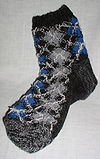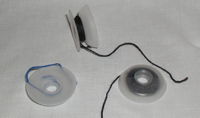
Intarsia (knitting)
Encyclopedia


Knitting
Knitting is a method by which thread or yarn may be turned into cloth or other fine crafts. Knitted fabric consists of consecutive rows of loops, called stitches. As each row progresses, a new loop is pulled through an existing loop. The active stitches are held on a needle until another loop can...
technique used to create patterns with multiple colours. As with the woodworking technique
Intarsia
Intarsia is a form of wood inlaying that is similar to marquetry. The term is also used for a similar technique used with small, highly polished stones set in a marble matrix .- History :...
of the same name, fields of different colours and materials appear to be inlaid in one another, but are in fact all separate pieces, fit together like a jigsaw puzzle.
Unlike other multicolour techniques (including Fair Isle
Fair Isle (technique)
thumb|Fair Isle [[sweater|jumper]] done in the traditional style, from Fair Isle.Fair Isle is a traditional knitting technique used to create patterns with multiple colours. It is named after Fair Isle, a tiny island in the north of Scotland, that forms part of the Shetland islands...
, slip-stitch colour
Slip-stitch knitting
Slip-stitch knitting is a family of knitting techniques that use slip stitches to make multiple fabrics simultaneously, to make extra-long stitches, and/or to carry over colors from an earlier row.-Basic methods:...
, and double knitting
Double knitting
Double knitting is a form of knitting in which two fabrics are knit simultaneously with two yarns on one pair of needles. The fabrics may be inseparable, as in interlock knitted fabrics, or they can simply be two unconnected fabrics...
), there is only one "active" colour on any given stitch, and yarn is not carried across the back of the work; when a colour changes on a given row, the old yarn is left hanging. This means that any intarsia piece is topologically several disjoint columns of colour; a simple blue circle on a white background involves one column of blue and two of white---one for the left and one for the right. Intarsia is most often worked flat
Flat knitting
Flat knitting is a method for producing knitted fabrics in which the work is turned periodically, i.e., the fabric is knitted from alternating sides...
, rather than in the round
Circular knitting
Circular knitting or knitting in the round is a form of knitting that creates a seamless tube. When knitting circularly, the knitting is cast on and the circle of stitches is joined. Knitting is worked in rounds in a spiral. Originally, circular knitting was done using a set of four or five...
. However, it is possible to knit intarsia in circular knitting using particular techniques.
Common examples of intarsia include sweaters with large, solid-colour features like fruits, flowers, or geometric shapes. Argyle
Argyle (pattern)
The argyle pattern is made of diamonds or lozenges. The word is sometimes used to refer to an individual diamond in the design but more commonly refers to the overall pattern. Most argyle layouts contain layers of overlapping motifs, adding a sense of three-dimensionality, movement, and texture...
socks and sweaters are normally done in intarsia, although the thin diagonal lines are often overlaid in a later step, using Swiss darning or sometimes just a simple backstitch
Backstitch
Backstitch or back stitch and its variants stem stitch, outline stitch and split stitch are a class of embroidery and sewing stitches in which individual stitches are made backward to the general direction of sewing...
.
Technique

Bobbin lace
Bobbin lace is a lace textile made by braiding and twisting lengths of thread, which are wound on bobbins to manage them. As the work progresses, the weaving is held in place with pins set in a lace pillow, the placement of the pins usually determined by a pattern or pricking pinned on the...
, modern intarsia bobbins resemble translucent plastic yo-yo
Yo-yo
The yo-yo in its simplest form is an object consisting of an axle connected to two disks, and a length of twine looped around the axle, similar to a slender spool...
s that can snap tight to prevent the yarn from unwinding.
After winding a few yards of each colour onto its own bobbin (and possibly several bobbins' worth of some colours), the knitter simply begins knitting their pattern. When they arrive at a point where the colour changes, the knitter brings the new colour up underneath the old one (to prevent holes) and starts knitting with it. If flat knitting, at the end of the row, the piece is turned round just as with regular knitting, and the knitter returns back the way they came.
The simplest intarsia pattern is for straight vertical stripes. After the first row, the pattern is continued by always working each stitch in the same colour as the previous row, changing colours at exactly the same point in each row. To make more elabourate patterns, one can let this colour boundary drift from row to row, changing colours a few stitches earlier or later each time.
Intarsia patterns are almost always given as charts (which, because of the mechanics of knitting, are read beginning at the lower right and continuing upward boustrophedon
Boustrophedon
Boustrophedon , is a type of bi-directional text, mostly seen in ancient manuscripts and other inscriptions. Every other line of writing is flipped or reversed, with reversed letters. Rather than going left-to-right as in modern English, or right-to-left as in Arabic and Hebrew, alternate lines in...
ically). The charts generally look like highly pixellated
Pixelation
In computer graphics, pixelation is an effect caused by displaying a bitmap or a section of a bitmap at such a large size that individual pixels, small single-colored square display elements that comprise the bitmap, are visible to the eye...
cartoon drawings, in this sense resembling dot-matrix computer graphics
Computer graphics
Computer graphics are graphics created using computers and, more generally, the representation and manipulation of image data by a computer with help from specialized software and hardware....
or needlepoint
Needlepoint
Needlepoint is a form of counted thread embroidery in which yarn is stitched through a stiff open weave canvas. Most needlepoint designs completely cover the canvas...
patterns (though usually without the colour nuance of the latter).
Knitting intarsia in the round
There are several techniques to execute intarsia when circular knitting. Executing intarsia "in-the-round" eliminates the need for seams and, in one case, turning the piece and working from the wrong side. Priscilla Gibson-Roberts discusses four techniques for knitting intarsia in the round in her book, Ethnic Socks & Stockings.External links
- http://explaiknit.typepad.com/let_me_explaiknit/2006/08/rock_around_the.html Site detailing methods of intarsia in the round.

